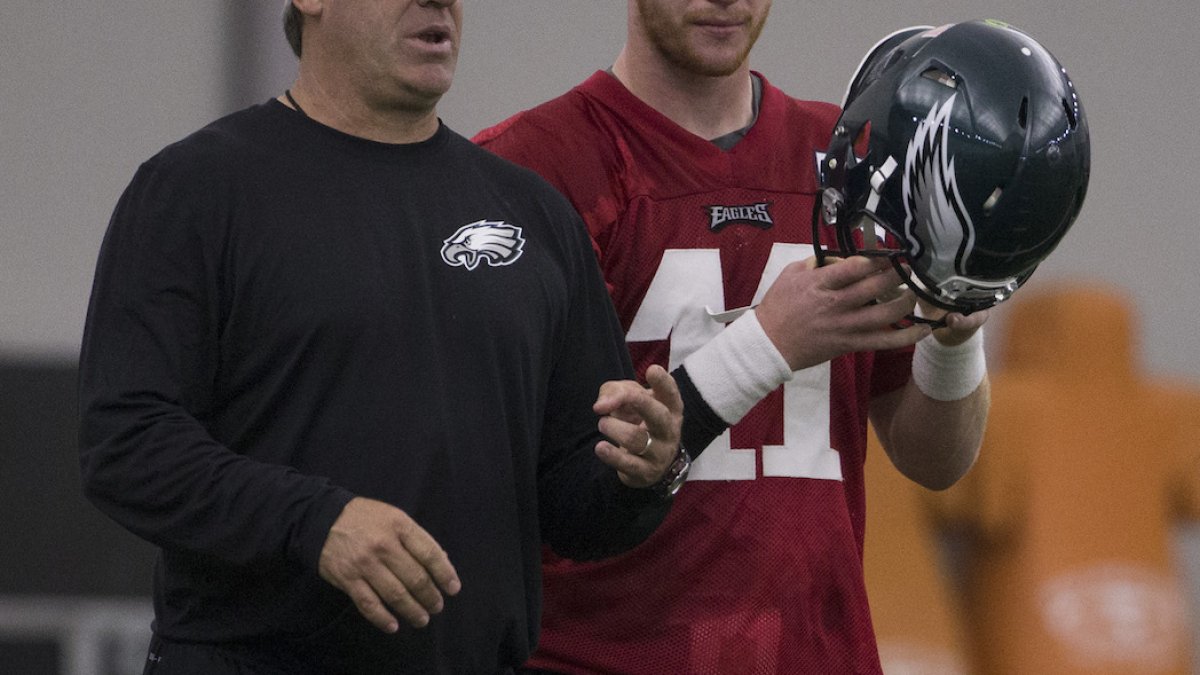Who should be the Eagles' No. 2 QB? The No. 2 QB in today’s NFL is a strange beast. Gone are the days where you could stash a second Hall of Famer on the roster just for the moment Joe Montana goes down hurt; there’s no team out there quietly placating their own Steve Young as he sits on the bench waiting to take over the reins.
This is a league where there aren’t enough quality quarterbacks to fill all 32 starting jobs, let alone get into the bench at the No. 2 spot. In reality, a team's second quarterback represents its damage limitation option.
The Eagles drafted Carson Wentz knowing he may not be ready to play right away, but that he would take some development and grooming. The need for that developmental time will keep Sam Bradford in the starting job—at least in the short-term—and consign Wentz to the bench. The question now is whether he or Chase Daniel should be the primary backup to Bradford.
The issue is that it’s a bit like choosing between riding a bicycle or catching a packed morning bus after you wrap your car around a streetlight. They’ll both serve a purpose, but neither one is the vehicle of choice for most morning commutes.
The Eagles know Wentz is the QB of the future. They drafted him with the second overall pick, and traded a lot to move up to get him, so his shot is secure. At that point, the only question is whether or not he is ready to start; when the answer to that question is “yes,” then he jumps to the top of the depth chart.
Having Wentz as the No. 2 serves little to no purpose, and could actually be a negative if Bradford gets hurt (hardly an outcome that would shock Vegas) and he is forced onto the field before he is ready. The Eagles are paying Daniel $7 million per season to be a backup; they might as well install him as the No. 2 and see what he has if he needs to see the field, staying on top of Wentz’s development from the safety of the bench.
(PFF Fantasy Insight: The PFF Friends and Family Dynasty League recently had its rookie draft, and Wentz was the second quarterback off the board. See where he went in relation to his fellow rookies.)
Daniel’s NFL career is six years old, but in that time he has played a total of 256 regular season snaps, and attempted just 76 passes. He has completed 64.5 percent of those, but we’re way short of being able to tell what kind of quarterback he is from that sample size.
Even his preseason performances have been inconsistent, though he was excellent in the 2015 preseason. The bottom line is that Daniel is being paid handsomely to be a No. 2 QB that can come in and do a job in case of injury to the starter. Wentz doesn’t need that uncertainty added to the work he already needs to do to adjust to the NFL game from life at North Dakota State, so there seems little sense in him ever occupying that No. 2 jersey in 2016. His career path should take him straight from the No. 3 to the No. 1 spot without ever needing to spend time as the primary backup, because in today’s NFL, that spot is a damage-limitation band-aid for an offense.
How good can Tyler Lockett be in Seattle? From the moment Seattle drafted Tyler Lockett in the third round of the 2015 NFL draft, PFF was telling people that he would be far more than just a return man if he got a chance on offense. In his final college season, he was the highest-graded receiver in the nation, and trailed only Amari Cooper in pass-catching grade alone. He may be only 5-foot-10 and well under 200 pounds, but so is Antonio Brown—the best receiver in the game.
During his rookie season, Lockett showed some of the same ability Brown has to just get open—despite being undersized—and finished the year with 664 receiving yards and half a dozen touchdowns to his name. This is an offense that does not rely on a single No. 1 receiver to overpower defenses and draw all of the targets. Doug Baldwin notched 14 touchdowns, but had just 99 targets, a figure 27 other receivers bettered. Julio Jones led the league with 193 passes thrown his way.
The Seahawks' offense is a very real meritocracy, where the most deserving will be fed the football. Baldwin has emerged as an excellent receiver and has seen his role increase, but Lockett could do the same thing alongside him. There is no reason he can’t top 1,000 receiving yards and hit double-digit touchdowns in year two, in addition to his work as a return man.
What hole does Calvin Johnson leave in Detroit? Calvin Johnson is officially not coming back out of retirement, so the Lions have a lot of that offense to spread around.
Johnson was thrown at 142 times in 2015 (24.0 percent of Matthew Stafford’s attempts), gained 1,214 yards (28.5 percent of his yards), and scored nine touchdowns (28.1 percent of Stafford’s passing scores). Detroit has over a quarter of their passing offense to redistribute amongst the current players on the roster, and this was a relatively low year in terms of Johnson’s market share on that team.
Stafford has always leaned on Johnson in a way that is only natural for a receiver so physically dominant, but maybe having to spread the ball around in a way he hasn’t had to before will be good for his play overall. The Lions have a lot of targets to find new homes for with Johnson officially stepping away from the field.


 © 2024 PFF - all rights reserved.
© 2024 PFF - all rights reserved.